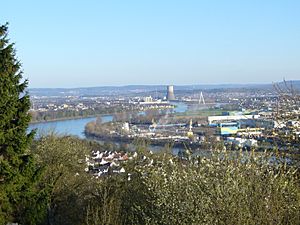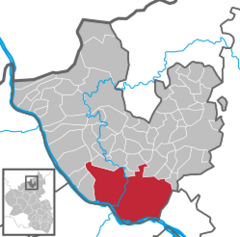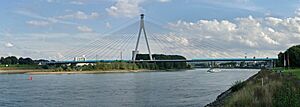Neuwied facts for kids
Quick facts for kids
Neuwied
|
|||
|---|---|---|---|

Neuwied
|
|||
|
|||
|
Location of Neuwied within Neuwied district
 |
|||
| Lua error in Module:Location_map at line 530: Unable to find the specified location map definition: "Module:Location map/data/Germany Rheinland-Pfalz" does not exist. | |||
| Country | Germany | ||
| State | Rhineland-Palatinate | ||
| District | Neuwied | ||
| Subdivisions | 13 Stadtteile | ||
| Area | |||
| • Total | 86.50 km2 (33.40 sq mi) | ||
| Elevation | 60 m (200 ft) | ||
| Population
(2022-12-31)
|
|||
| • Total | 65,986 | ||
| • Density | 762.84/km2 (1,975.76/sq mi) | ||
| Time zone | UTC+01:00 (CET) | ||
| • Summer (DST) | UTC+02:00 (CEST) | ||
| Postal codes |
56501–56567
|
||
| Dialling codes | 02631 und 02622 | ||
| Vehicle registration | NR | ||
Neuwied is a town in the north of Germany. It is located in the state of Rhineland-Palatinate. Neuwied is the main town of the Neuwied District.
The town sits on the east bank of the Rhine River. It is about 12 kilometers (7.5 miles) northwest of Koblenz. Neuwied is also on the railway line that connects Frankfurt am Main to Cologne. The town has 13 smaller areas, or districts, that are part of it. These include Heimbach-Weis, Gladbach, and Engers. Heimbach-Weis is the largest district, with around 8,000 people living there.
Contents
History of Neuwied
How Neuwied Was Founded
Neuwied was started in 1653 by Count Frederick III of Wied. It was built as a fortress where a village called Langendorf used to be. That village had been destroyed during the Thirty Years' War (1618–1648).
The Count wanted Neuwied to be the new main town for his area. He also wanted it to protect the only way to reach the Rhine River. This would help the small state, which was poor after the war, to join in the trade on the Rhine.
Religious Freedom and Growth
At first, not many people wanted to live in Neuwied. This was because it was in an area that often flooded. So, the Counts of Wied, especially Frederick III and John Frederick Alexander, offered special freedoms. They allowed people to govern themselves and practiced religious tolerance. This was different from other parts of their land.
These freedoms attracted many people who were seeking religious freedom. They came from other German areas, and also from France and Switzerland. Because of this, the town's population grew very quickly. By the mid-1700s, people from seven different religious groups lived in Neuwied. These included Calvinists, Lutherans, Catholics, Mennonites, and Jews.
Important Crafts and Industry
These new settlers and their families helped Neuwied's economy grow a lot in the 1700s and 1800s. Famous furniture makers like Abraham and David Roentgen, who were Moravian Brethren, created beautiful pieces. These were found in royal palaces all over Europe. A Mennonite clockmaker named Peter Kinzing also made amazing clocks.
Count John Frederick Alexander also started the Rasselstein iron rolling mill. This made Neuwied one of the first places in Germany to have large factories.
Battles and Famous Connections
In 1797, a French army led by General Louis Lazare Hoche won a battle against the Austrians near Neuwied. This was called the Battle of Neuwied.
Neuwied is also the hometown of the family of John D. Rockefeller. His family came from Neuwied in the 16th century. They might have been French Huguenot refugees. His family later moved to North America in 1710. This was during a time when many German refugees came to New York.
William of Wied, who was briefly the King of Albania in 1914, was also born in Neuwied.
Geography of Neuwied
Districts and Location
Neuwied covers an area of 86.5 square kilometers (33.4 square miles). This area is divided into several suburban districts. Some of these districts are:
- Altwied
- Block
- Engers
- Feldkirchen
- Gladbach
- Heimbach-Weis
- Irlich
- Niederbieber
- Oberbieber
- Rodenbach
- Segendorf
- Torney
The main part of Neuwied and the old village of Heddesdorf are not listed as separate districts. They are part of the core city area. The abandoned village of Rockenfeld is also part of Neuwied today. This village is thought to be where the famous Rockefeller family got their name.
Flood Protection
The center of Neuwied is built on an old part of the Rhine River bed. This means it is at high risk of flooding. Neuwied is one of the few towns in the area that has special walls called levees to protect it from floods. These levees help keep the town safe.
Population Growth
In the beginning, only a few thousand people lived in Neuwied. The population did not grow much for a long time because of wars and famines.
However, when factories started to appear in the 1800s, more people moved to Neuwied. The number of people grew from 5,600 in 1831 to 18,000 in 1905. By 1970, about 31,400 people lived there. After several nearby communities joined the town, the population jumped to 63,000. As of June 30, 2005, Neuwied had 66,455 residents.
Getting Around Neuwied
Road Connections
Neuwied is connected to Germany's main national roads, called Bundesstraßen. These include the B9, B42, and B256. Major highways, known as Autobahnen, like the A3, A48, and A61, are also easy to reach from Neuwied.
Train Travel
Neuwied has two train stations: Neuwied and Engers. Both are on the Right Rhine line. A third station is being considered. These stations connect to major cities like Koblenz Hauptbahnhof in the south and Köln Hauptbahnhof in the north. From these stations, you can reach Germany's high-speed train network.
Trains run frequently during the day:
- An hourly semi-fast train (the Rhein-Erft-Express) goes between Koblenz, Neuwied, and Cologne.
- An hourly train that stops at all stations goes between Koblenz, Neuwied, and Cologne.
- An hourly semi-fast train from VIAS goes between Neuwied, Koblenz, and Wiesbaden.
It takes about 15 to 20 minutes to get to Koblenz by train. Cologne is about 70 to 80 minutes away.
Bus Services
Within Neuwied, there is a bus network. Buses usually run every 20, 30, or 60 minutes, depending on the route. Most bus lines are run by Transdev. All public transport, including buses and trains, is part of the Verkehrsverbund Rhein-Mosel system. This means your ticket is valid for different types of transport within certain areas and times. You can find more information on timetables at [1].
Sister Cities
Neuwied has special connections with other cities around the world. These are called "sister cities" or "twin towns."
Notable People from Neuwied
Many interesting people were born in or lived in Neuwied. Here are a few:
- Hermann of Wied (1477–1552), an important church leader who wanted to change the church.
- Gotthard Rockenfeller (1590–1695), an ancestor of the famous American businessman John D. Rockefeller.
- David Roentgen (1743–1807), a very skilled cabinetmaker.
- Peter Kinzing (1745–1816), a talented watchmaker and mechanic.
- Prince Maximilian of Wied-Neuwied (1782–1867), a naturalist who studied plants, animals, and different cultures.
- Elisabeth of Wied (1843–1916), who became the Queen of Romania and was also a poet.
- William, Prince of Albania (1876–1945), who was the ruler of Albania for a short time.
- Carl Einstein (1885–1940), a writer and art historian.
- Friedrich Wolf (1888–1953), a doctor and writer.
- Mike Rockenfeller (born 1983), a professional race car driver.
- Isaac Bonga (born 1999), a professional basketball player.
See also
 In Spanish: Neuwied para niños
In Spanish: Neuwied para niños





